Asbestos exposure has long been a public health concern, particularly in cities like Burlington, where older buildings and industrial history have left a legacy of risk. Understanding the Burlington Asbestos Legal Question is critical for homeowners, property managers, and workers who might be exposed to this hazardous material.
This comprehensive guide will walk you through the risks, Burlington asbestos regulations, and the legal options available to those affected.
Overview of the Asbestos Issue in Burlington
Asbestos is a major concern in Burlington, especially in older buildings and industrial areas. Many structures, like factories and homes, were built using materials that contain asbestos. This was common because asbestos was known for its fire-resistant properties. However, when these materials are disturbed during repairs or renovations, dangerous asbestos fibers can be released into the air.
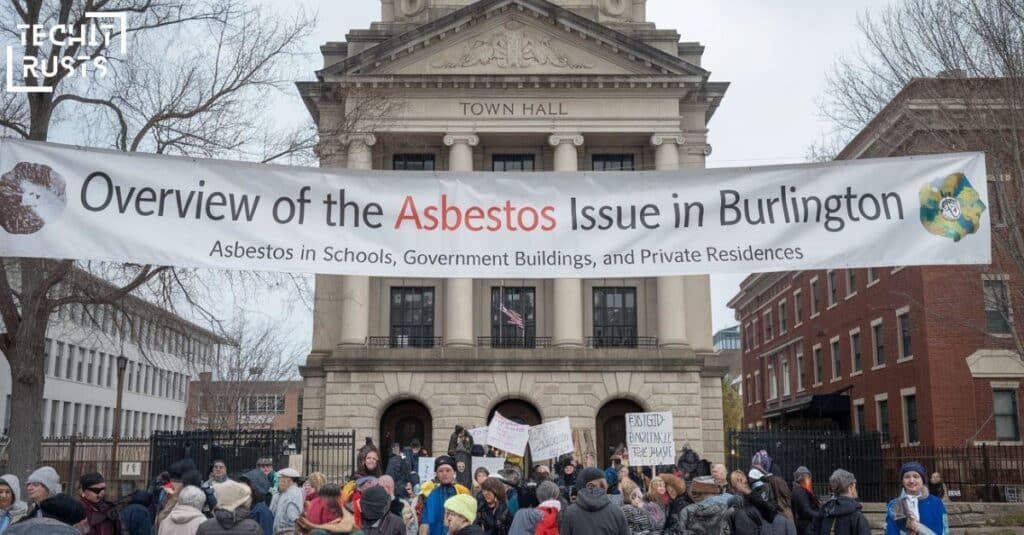
This can put people at risk of exposure, which may lead to serious health issues like lung cancer and mesothelioma. Even though asbestos has been heavily regulated, it is still present in many places. People may not realize they are exposed because asbestos-related diseases often develop years after contact.
The long delay between exposure and illness makes it hard to identify when and where exposure happened. In Burlington, there are strict rules for how asbestos must be handled, but the risk remains high in older buildings and during construction projects.
What is Asbestos?
Asbestos is a naturally occurring mineral that was widely used in construction, insulation, and various industrial applications due to its durability and fire-resistant properties. Unfortunately, asbestos is highly toxic, and when its fibers become airborne and inhaled, they can cause serious health issues like asbestos-related diseases, including mesothelioma and lung cancer.
History of Asbestos in Burlington
Burlington, like many other cities, saw a significant boom in construction during the mid-20th century. This period coincided with heavy asbestos use in building materials such as:
- Insulation
- Roofing shingles
- Floor tiles
- Cement products
- Pipes
Many of the buildings in Burlington built before the 1980s contain asbestos. While asbestos use has been banned or heavily restricted in most forms since the 1980s, it remains in many structures, posing ongoing risks.
Current Status of Asbestos in Burlington
Although federal regulations govern asbestos removal and disposal, many older buildings in Burlington still contain asbestos, especially in schools, factories, and residential buildings. Asbestos exposure in Burlington has been linked to numerous health risks, and public health officials continue to warn residents and workers about the potential dangers.
The Vermont Department of Environmental Conservation (DEC) and other local agencies work to ensure that asbestos in existing structures is properly managed, but risks remain, particularly for those involved in construction, renovation, and demolition work.
Health Risks and Long-Term Consequences of Asbestos Exposure
Asbestos exposure poses serious health risks, especially to the lungs. When asbestos fibers are inhaled, they can get trapped in the lungs and cause inflammation or scarring. Over time, this can lead to serious illnesses like asbestosis, a lung disease that causes breathing difficulties.
The most severe health risks include lung cancer and mesothelioma, a rare but aggressive cancer that affects the lining of the lungs, heart, or abdomen. The long-term consequences of asbestos exposure often take years or even decades to appear. This delayed effect makes it hard to detect the exposure early and get treatment before symptoms worsen.
Mesothelioma and other asbestos-related diseases often have poor survival rates due to late diagnosis. Even minimal exposure to asbestos can be harmful, meaning that safety measures and early detection are crucial for preventing severe health issues.
Understanding Asbestos-Related Diseases
When asbestos fibers are inhaled, they can become lodged in the lungs, leading to asbestos-related diseases such as:
- Mesothelioma: A rare but aggressive form of cancer that affects the lining of the lungs, abdomen, or heart.
- Asbestosis: A chronic lung disease caused by scarring of lung tissue due to asbestos fibers.
- Lung Cancer: Asbestos exposure can significantly increase the risk of lung cancer, particularly in smokers.
Symptoms of Asbestos-Related Diseases
Symptoms of asbestos-related diseases often do not appear until 20 to 50 years after exposure, making early detection difficult. Common symptoms include:
- Persistent cough
- Shortness of breath
- Chest pain
- Fatigue
- Weight loss
Given the long latency period, many victims of asbestos exposure are diagnosed years after their initial exposure, making asbestos litigation challenges more complicated.
Who is Most at Risk?
The following groups are at the highest risk for asbestos exposure in Burlington:
- Construction workers: Particularly those involved in renovation or demolition of older buildings.
- Factory workers: Especially those who worked with materials containing asbestos.
- Homeowners: Those renovating or repairing older homes without proper asbestos removal guidelines.
- Firefighters and first responders: They often encounter asbestos during building fires or accidents involving older structures.
How Asbestos Exposure Affects the Burlington Community
The ongoing risk of asbestos exposure in Burlington has prompted local health departments to issue warnings and educate the public about the dangers of asbestos. Several asbestos legal cases have emerged from Burlington, where individuals have sued for compensation after being diagnosed with mesothelioma or other asbestos-related conditions.
Public health awareness campaigns have also increased, aiming to reduce asbestos exposure through proper abatement and removal practices.
Regulations Governing Asbestos in Burlington
In Burlington, strict regulations are in place to manage asbestos and protect public health. Both federal and local laws govern how asbestos must be handled, removed, and disposed of. At the federal level, the Clean Air Act (CAA) and the Occupational Safety and Health Administration (OSHA) set safety standards for asbestos management.
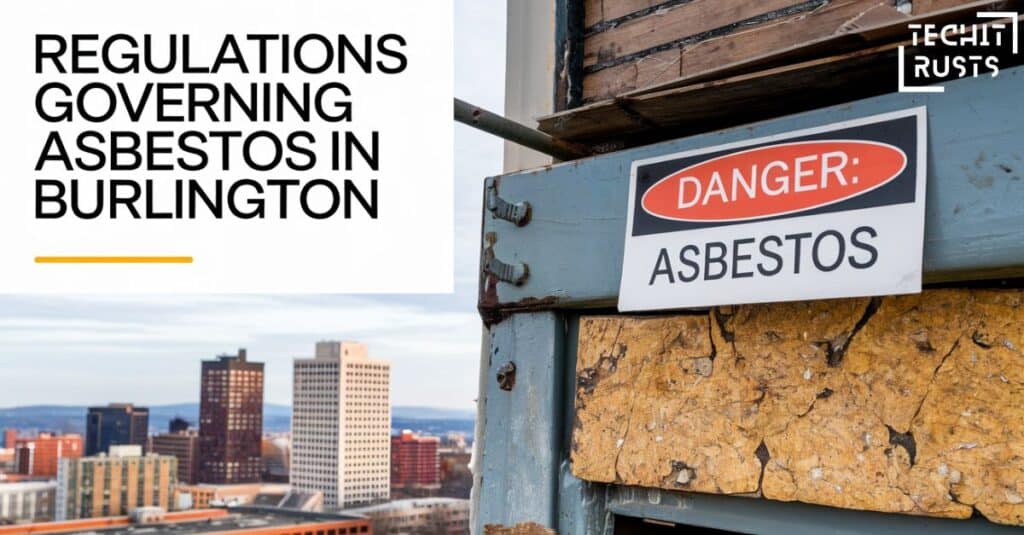
These laws require businesses and property owners to follow strict guidelines when working with asbestos to prevent exposure. Locally, the Vermont Department of Environmental Conservation (DEC) enforces additional rules. These include mandatory inspections before renovation or demolition projects in older buildings.
Certified professionals are required for asbestos removal, ensuring that only trained experts handle dangerous materials. These regulations aim to minimize the risk of asbestos exposure in Burlington, protecting workers, residents, and the environment from harmful fibers.
Federal Regulations
At the federal level, several key laws govern the use and management of asbestos:
- Toxic Substances Control Act (TSCA): Under TSCA, the U.S. Environmental Protection Agency (EPA) has broad authority to regulate the use and disposal of asbestos.
- Clean Air Act (CAA): This law requires that asbestos emissions be controlled to protect public health.
- Occupational Safety and Health Administration (OSHA): OSHA regulates workplace exposure to asbestos, setting permissible exposure limits and requiring proper safety protocols in workplaces where asbestos is present.
State and Local Regulations
Burlington follows the general Vermont asbestos regulations, which provide additional protections for workers and residents. Key aspects of asbestos regulations in Burlington include:
- Vermont DEC Asbestos Program: This program ensures proper asbestos abatement and disposal practices.
- Permits for Asbestos Removal: Property owners must obtain permits before any asbestos removal or abatement work is conducted.
- Inspection Requirements: Buildings slated for demolition or major renovation must be inspected for asbestos before work begins.
Enforcement and Compliance
The Vermont Department of Environmental Conservation (DEC) is responsible for enforcing asbestos regulations in Burlington. This includes:
- Regular inspections of buildings for compliance.
- Enforcement actions against violators.
- Public reporting of non-compliant property owners or contractors.
However, gaps in enforcement can occur, particularly with older buildings that haven’t been inspected in years.
Key Asbestos Removal Guidelines in Burlington
When it comes to asbestos removal guidelines in Burlington, the process must be handled by certified professionals who follow strict safety procedures. Some key steps include:
- Asbestos Surveys: Before any demolition or renovation, an asbestos survey must be conducted by a licensed inspector.
- Containment: Areas containing asbestos must be sealed off during removal to prevent fibers from becoming airborne.
- Disposal: Asbestos waste must be disposed of in a certified hazardous waste facility.
Legal Ramifications of Asbestos Exposure
Asbestos exposure can lead to serious legal consequences for those responsible, including property owners, employers, and manufacturers. In Burlington, these parties have a legal duty to ensure that asbestos is safely managed in buildings and workplaces.
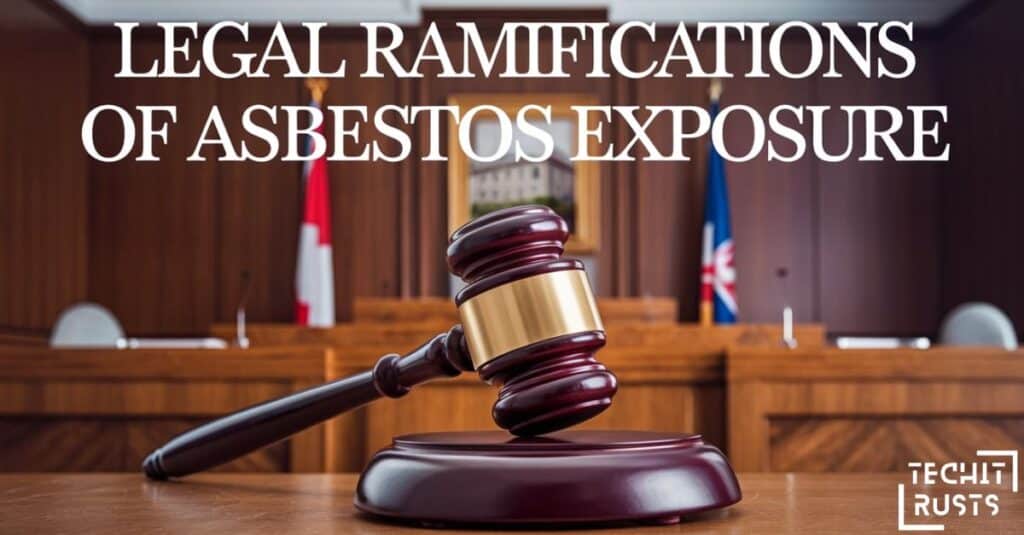
If they fail to do so, and someone is harmed by asbestos exposure, they can face lawsuits for negligence. Victims of exposure may seek compensation for medical expenses, lost wages, and suffering caused by asbestos-related diseases.
Lawsuits often target employers who fail to protect their workers from asbestos or manufacturers of asbestos-containing products. Legal claims can be complex, as proving exposure and linking it to illnesses like mesothelioma can be challenging due to the long delay between exposure and symptoms.
Courts may hold responsible parties accountable for ignoring safety regulations, and victims can receive significant compensation to cover medical costs and other damages related to asbestos exposure.
Who Can Be Held Liable?
In asbestos legal cases, several parties may be held liable for asbestos exposure:
- Property Owners: Property owner liability is significant when asbestos is found in a building they own, especially if they failed to inform tenants or take necessary precautions.
- Employers: Employers who expose workers to asbestos without proper protection can face lawsuits for negligence.
- Manufacturers: Companies that produced asbestos-containing materials may still be held accountable for damages, even if the exposure occurred decades ago.
Types of Claims: Personal Injury vs. Wrongful Death
Asbestos lawsuits generally fall into two categories:
- Personal Injury: Filed by individuals suffering from asbestos-related diseases.
- Wrongful Death: Filed by family members of someone who died due to asbestos exposure.
Both types of claims can result in asbestos-related compensation, including:
- Medical expenses
- Lost wages
- Pain and suffering
- Punitive damages
Compensation for Asbestos Victims
Victims of asbestos exposure can receive compensation through various avenues, including:
- Asbestos Trust Funds: Established by bankrupt asbestos manufacturers, these funds are designed to compensate victims without the need for a lawsuit.
- Settlements: Many asbestos legal cases settle out of court, offering victims compensation without a lengthy trial.
- Court Verdicts: In some cases, victims may win substantial compensation through a court verdict if the evidence supports their claim.
Below is a table that outlines the typical compensation amounts for asbestos-related claims:
| Type of Compensation | Average Amount |
| Medical Expenses | $10,000 – $100,000 |
| Lost Wages | Varies by case |
| Pain and Suffering | $100,000 – $1,000,000 |
| Punitive Damages | Up to $10,000,000 in extreme cases |
Key Legal Challenges in Asbestos Litigation
Asbestos litigation is complex due to the long latency period of asbestos-related diseases. It can take 20 to 50 years for symptoms of diseases like mesothelioma or lung cancer to appear after exposure.
This long delay makes it difficult to prove when and where the exposure happened, which is a major challenge in court cases. Gathering sufficient evidence, such as medical records and employment history, is essential but can be complicated and time-consuming.
Another challenge is identifying the responsible party. In many cases, individuals were exposed to asbestos in multiple locations over many years. It’s often hard to pinpoint exactly who should be held liable—whether it’s a property owner, employer, or manufacturer.
Additionally, the burden of proof is on the victim to show that the exposure directly caused their illness, which requires expert testimony and thorough documentation. These factors make asbestos litigation lengthy and challenging for those seeking justice.
Proving Causation
One of the biggest asbestos litigation challenges is proving causation. Because asbestos-related diseases have long latency periods, it can be difficult for plaintiffs to establish when and where they were exposed. This is where expert testimony and medical evidence become crucial.
Statute of Limitations in Vermont
In Vermont, the statute of limitations for asbestos lawsuits is generally three years from the date of diagnosis. For wrongful death claims, family members have two years from the date of death to file a lawsuit.
Bankruptcy and Asbestos Trust Funds
Many companies that manufactured asbestos products have declared bankruptcy, which complicates asbestos litigation. However, these companies have set up asbestos trust funds to compensate victims. This allows individuals exposed to asbestos in Burlington to seek compensation without going through the bankruptcy court.
Prominent Asbestos Legal Cases in Burlington
Burlington has seen several significant legal cases related to asbestos exposure that highlight the challenges and consequences faced by victims. One notable case involved workers from a local manufacturing plant who developed serious illnesses after prolonged exposure to asbestos-containing materials.
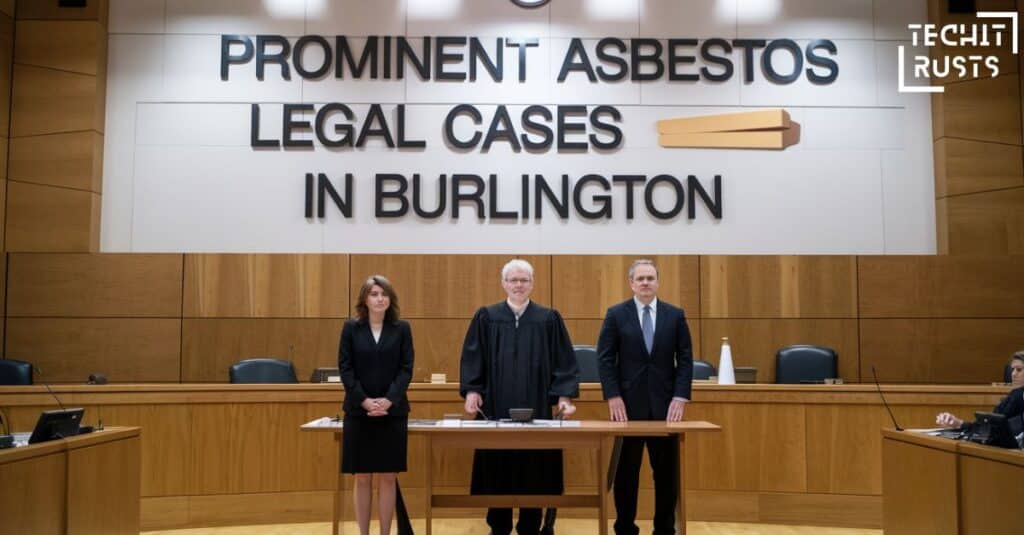
These workers filed lawsuits against the company for failing to provide a safe working environment and adequate warnings about the risks of asbestos. The case brought attention to the need for stricter safety measures and led to substantial settlements for the affected individuals. Another prominent case involved a property owner whose tenants developed asbestos-related diseases after living in an older building that contained asbestos.
The tenants claimed that the owner failed to manage the asbestos properly, exposing them to dangerous fibers. This case emphasized the legal responsibilities of property owners to ensure safe living conditions and prompted discussions on regulatory enforcement in Burlington. The outcomes of these cases have influenced local asbestos policies and heightened awareness of the need for better asbestos management practices.
Case Summaries
Several asbestos legal cases in Burlington have set important legal precedents. For example:
- Burlington School Case: A school district was found liable after failing to properly manage asbestos in a public school, leading to exposure for students and staff. The school district was ordered to pay significant damages and to perform a full asbestos abatement.
- Residential Asbestos Exposure Case: In another case, tenants sued a landlord after discovering asbestos during a renovation. The court held the landlord liable for failing to disclose the presence of asbestos and ordered compensation for medical monitoring.
Impact of Legal Precedents
These cases have helped shape Burlington asbestos regulations and increased the accountability of property owners and employers. They have also raised awareness of the importance of proper asbestos removal and abatement.
Prevention and Safety Measures
Preventing asbestos exposure in Burlington requires strict adherence to safety protocols, especially in older buildings where asbestos may be present. Property owners and contractors must conduct thorough inspections before any renovation or demolition work. Identifying asbestos-containing materials is crucial to ensure that proper safety measures are in place.
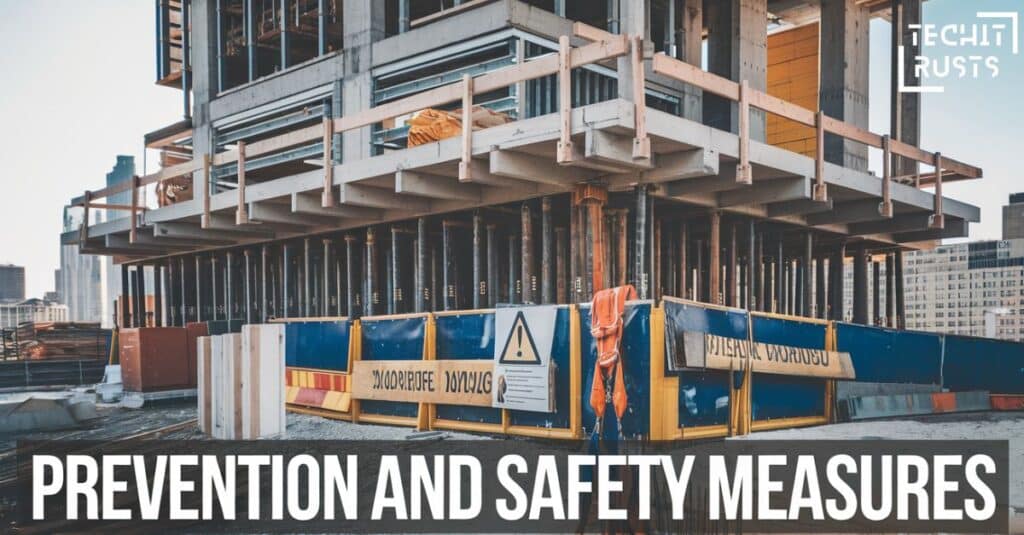
If asbestos is found, it should be managed or removed by certified professionals trained in safe abatement practices. This helps minimize the risk of harmful fibers being released into the air. Public education is also essential for preventing asbestos exposure. Local health departments and community organizations often run awareness campaigns to inform residents about the dangers of asbestos and safe handling practices.
Workshops and informational sessions teach people how to recognize asbestos materials and what steps to take if they encounter them. By promoting safety measures and ensuring proper training for workers, Burlington aims to reduce the incidence of asbestos-related illnesses in the community and protect public health.
Identifying Asbestos in Homes and Buildings
Identifying asbestos in older buildings is critical. Homeowners and contractors should follow these steps:
- Inspect: If your home or building was built before 1980, have it inspected for asbestos by a certified professional.
- Test: Samples should be collected and tested in a lab to confirm the presence of asbestos.
- Abate: If asbestos is found, follow asbestos removal guidelines in Burlington and hire a licensed abatement contractor.
Safe Asbestos Removal and Abatement
Safe asbestos abatement involves several steps:
- Containment: Isolate the area where asbestos is present.
- Wet Methods: Use water to keep asbestos fibers from becoming airborne during removal.
- Proper Disposal: Dispose of asbestos waste in sealed containers at a designated hazardous waste facility.
Public Awareness and Prevention Programs
Burlington has several public awareness initiatives to educate residents and workers about asbestos exposure. These programs aim to reduce risk through:
- Training and Certification Programs: For contractors involved in asbestos removal.
- Public Information Campaigns: Focused on the dangers of asbestos-related diseases and how to avoid exposure.
Legal Options for Individuals Exposed to Asbestos
Individuals exposed to asbestos in Burlington have several legal options to seek compensation for their health issues. One of the most common routes is filing a personal injury lawsuit against responsible parties, such as property owners, employers, or manufacturers of asbestos-containing products. Victims can claim damages for medical expenses, lost wages, pain and suffering, and other related costs.
To strengthen their case, it is important for individuals to gather evidence of their exposure and any resulting health problems. In addition to personal injury lawsuits, victims may also explore other legal avenues, such as asbestos trust claims. Many companies that used asbestos have established trust funds to compensate victims without going through lengthy court processes.
Consulting with an experienced asbestos attorney is crucial for individuals navigating these legal options. A specialized lawyer can help assess the case, identify liable parties, and ensure that victims pursue the most effective legal strategies to obtain the compensation they deserve.
Filing a Lawsuit
If you’ve been exposed to asbestos, it’s important to know your legal options for asbestos victims. Filing a lawsuit may provide you with compensation for medical expenses, lost income, and other damages.
Class Action vs. Individual Lawsuits
Victims of asbestos exposure in Burlington can file individual lawsuits or join class action lawsuits. The choice depends on the specifics of the case and whether multiple victims are affected by the same source of exposure.
Role of Asbestos Lawyers in Burlington
Hiring specialized asbestos lawyers in Burlington is crucial for navigating complex asbestos litigation. Experienced attorneys can help gather evidence, file claims, and represent victims in court. They also work on contingency, meaning they only get paid if you win your case.
Challenges in Asbestos Regulation and Litigation
Asbestos regulation and litigation face significant challenges that complicate efforts to protect public health. One major issue is the enforcement of regulations in older buildings where asbestos-containing materials are more likely to be present. Limited resources and staffing shortages in regulatory agencies can lead to insufficient inspections and oversight.
This lack of enforcement increases the risk of exposure, as property owners and contractors may not comply with safety protocols. Ensuring that older structures meet current safety standards is crucial for preventing health risks associated with asbestos. In litigation, the long latency period of asbestos-related diseases poses additional obstacles.
Victims often struggle to prove the link between their illness and specific instances of exposure, as symptoms can take decades to manifest. This complicates the process of establishing liability, particularly when multiple parties may be involved. Furthermore, the complexity of asbestos regulations can lead to confusion among property owners, contractors, and businesses, resulting in unintentional violations.
Addressing these challenges requires ongoing education, improved funding for regulatory enforcement, and increased collaboration between public health agencies, legal experts, and the community.
Enforcement of Regulations in Older Buildings
One of the key challenges in Burlington asbestos regulations is enforcing compliance in older buildings. Many of these structures have not been inspected for decades, and property owners may be unaware of or ignore their obligations.
Inadequate Penalties and Gaps in the Law
While Burlington asbestos regulations exist, the penalties for violations can be insufficient to deter non-compliance. Stronger enforcement and harsher penalties may be needed to protect public health.
Litigation Bottlenecks
Another challenge is the backlog of cases in Vermont’s courts. Asbestos lawsuits can take years to resolve, delaying compensation for victims who need it to cover medical expenses and other costs.
Seeking Legal Help in Burlington
If you believe you have been exposed to asbestos in Burlington, seeking legal help is a crucial step in protecting your rights. An experienced asbestos attorney can guide you through the complex legal processes associated with filing a claim. These specialized lawyers understand the intricacies of asbestos litigation and can help you gather the necessary evidence to support your case.
They can also advise you on your legal options, including personal injury lawsuits or trust fund claims, depending on the circumstances of your exposure. Finding a reputable asbestos lawyer in Burlington involves researching attorneys with a proven track record in similar cases. Look for legal professionals who specialize in asbestos litigation and are familiar with both federal and local regulations.
Many attorneys offer free consultations to discuss your case and outline potential legal strategies. Hiring a knowledgeable attorney not only increases your chances of securing fair compensation but also provides peace of mind during a challenging time. Taking this step can help ensure that you receive the support and representation you need to navigate the legal landscape effectively.
When to Contact a Lawyer
If you believe you’ve been exposed to asbestos, it’s critical to contact an asbestos lawyer in Burlington as soon as possible. Signs that you may need legal representation include:
- Discovery of asbestos in your home or workplace.
- Diagnosis of an asbestos-related illness.
- Non-compliance by a landlord, employer, or contractor.
What to Expect in an Asbestos Lawsuit
An asbestos lawsuit typically involves several stages:
- Filing a Complaint: Your lawyer will file a complaint in court, detailing your exposure and damages.
- Discovery: Both sides gather evidence, including medical records, expert testimony, and documentation of asbestos exposure.
- Settlement or Trial: Many asbestos legal cases settle before trial, but some go to court, where a judge or jury decides the outcome.
Resources for Burlington Residents
Burlington residents seeking legal help can turn to:
- Vermont Bar Association: For finding qualified asbestos attorneys.
- Local Legal Aid Organizations: For free or low-cost legal advice.
- Asbestos Advocacy Groups: For support and guidance through the legal process.
Frequently Asked Questions
What Should I Do If I Find Asbestos in My Burlington Home?
If you find asbestos in your home, contact a certified asbestos inspector to assess the situation. Do not attempt to remove it yourself.
Can I File a Lawsuit for Asbestos Exposure in Burlington?
Yes, you can file a lawsuit if you have been exposed to asbestos and suffered health consequences as a result.
What Compensation Can I Receive for Asbestos Exposure?
You may be entitled to compensation for medical expenses, lost wages, pain and suffering, and punitive damages.
How Can I Find a Reputable Asbestos Lawyer in Burlington?
Contact the Vermont Bar Association or search for specialized asbestos lawyers in Burlington with experience in asbestos litigation.
What Are the Main Health Risks Associated with Asbestos Exposure?
The main health risks include mesothelioma, lung cancer, and asbestosis.
Are There Specific Regulations for Asbestos Management in Burlington?
Yes, asbestos regulations in Burlington are governed by federal laws like TSCA, as well as state and local guidelines enforced by the Vermont DEC.
Conclusion
The Burlington asbestos legal question is a critical issue for many residents, workers, and property owners. Understanding the risks, regulations, and legal avenues available is essential for protecting your health and your rights.
By staying informed and seeking help when needed, you can navigate the complex landscape of asbestos litigation and ensure that you or your loved ones receive the compensation and protection you deserve.
>>>Read Also: Unveiling the White Oak Global Advisors Lawsuit: Key Allegations and Industry Impact

Ashi is the site admin for “techitrusts.com” and specializes in writing within the journal category. If you need more detailed information about his background or work, feel free to ask!